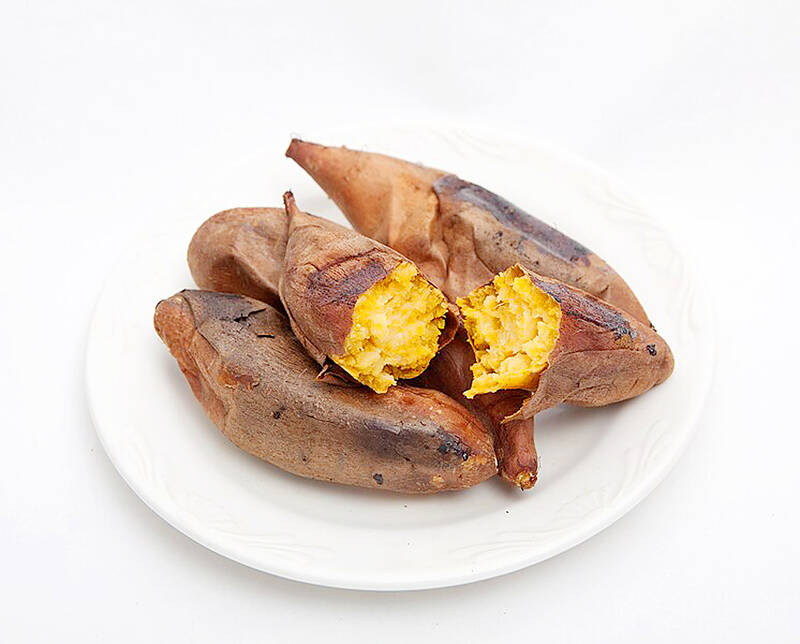It is often said that, to many Taiwanese, the shape of Taiwan resembles a sweet potato, a root vegetable that has fed countless Taiwanese people. Sweet potatoes are now usually eaten as part of a healthy diet and to lose weight, but to Taiwanese people in the early 20th century, they were an important food during difficult times. Sweet potatoes can grow well in infertile soils, whereas rice requires fertile soil and much water to grow. At that time, when many people could not afford a bowl of rice to eat, they often extended the rice by adding dried sweet potato shreds to the rice as it cooked, often with the final product having more sweet potato than rice. Other than being eaten as a staple food, sweet potatoes were often roasted as a snack during that time when people didn’t have many dessert options in their lives.
有人常形容台灣島外觀像番薯,番薯也餵飽無數的台灣人。現在人常為了養生和減重吃番薯,但在20 世紀初期,對台灣人來說,番薯是貧困時期賴以為生的重要食糧。有別於需要肥沃土壤的稻米,番薯在貧瘠的土地也能生長。當時許多人吃不起白米飯,於是將番薯刨成絲和米一起煮,甚至放得比米還要多。烤番薯也成了當時少有的點心之一。
root (n.) 塊根

Photo: Wiki Commons 照片: Wiki Commons
infertile (adj.) 不肥沃的
Roasting sweet potatoes is a simple task that doesn’t require much skill. Decades ago, it was not hard to find earth ovens made of rocks and dirt in the fields with roasted sweet potatoes inside. Once fully cooked, the sweet potato’s thick skin is easily peeled away to reveal a soft and sweet interior, providing a feeling of fullness and satisfaction that many Taiwanese senior citizens and middle-aged people cherish as a childhood memory.
烤地瓜不難,幾十年前田野間常看到烤番薯的土窯,烤好後就撕開厚厚的地瓜皮,裡面軟糯甜膩,頗有飽足感,是許多台灣長輩及中生代的童年回憶。
peel (v.) 剝去?皮
Even though we can now afford to eat rice every day, we still choose to eat sweet potatoes because they are both healthy and delicious. As more people become aware of the health benefits of sweet potatoes, such as aiding in weight loss, their popularity and price have increased. It’s fascinating to witness the transformation of sweet potatoes from being considered a vegetable associated with poverty to becoming a modern-day favorite for weight loss. They are now available in convenience stores to meet the growing demand for healthier and more convenient dietary options.
隨著人們經濟水準提升,人人都吃得起白米飯,番薯卻並未從我們的餐桌上消失。人們意識到番薯養生、有助於減重等好處,價格因此水漲船高,以前窮苦人家的食物,居然成為現代人的減重聖品。現在走進台灣便利商店就能買到烤番薯,提供顧客便利又健康的早餐選擇。
transformation (n.) 徹底改變
poverty (n.) 貧困,貧窮
dietary (adj.) 飲食的
Although many Taiwanese people have been eating sweet potatoes their entire lives, sweet potatoes are not native to Taiwan but were brought here in the 17th century. When General Cheng Cheng-kung’s army settled in Taiwan, the easily grown sweet potatoes provided sustenance for his troops. Without this important food source, Cheng’s army might have been unable to survive, which could have led to a very different outcome in Taiwan’s history.
台灣人雖然吃番薯吃了一輩子,但其實番薯不是台灣原生植物,17 世紀才引入台灣。鄭成功的軍隊開墾台灣時還努力耕種番薯,維持駐軍所需糧食,如果沒有番薯,台灣的歷史可能會重寫。
sustenance (n.) 食物,糧食
The sweet potato has become a symbol of resilience in Taiwan as it can grow even in challenging conditions. This association may have originated in the nicknames used to distinguish the local and Chinese armies after the Nationalist government relocated to Taiwan in 1949. The soldiers from China referred to the local Taiwanese as “sweet potato” and local Taiwanese called the Chinese soldiers “taro.” Today, sweet potatoes are an integral part of Taiwanese culture, not only as a dietary staple but also as a symbol of resilience and strength.
番薯因為在貧瘠的土壤也可以生長,成為適應力的代名詞。1949年國民政府遷台後,來到台灣的外省軍人,便稱「番薯」為「地瓜」,台灣人稱呼自己為「番薯」,並以「芋仔」來代稱外省軍人。因此,番薯之所以和台灣人密不可分,不只因為是主食,也因為象徵的台灣人堅忍不拔的精神。
resilience (n.) 適應力
文章由書林出版公司提供:
www.bookman.com.tw

A: When is the Lantern Festival? B: The festival is celebrated on the 15th day of the first month of the lunar calendar, which fell on Feb. 12 this year. A: Oh no! Did I miss the 2025 Taipei Lantern Festival? B: Yes, you did. But you can still go to the 2025 Taiwan Lantern Festival in Taoyuan, which will run until this Sunday. A: Let’s go admire the exuberant lanterns. A: 元宵節到底是哪一天? B: 就是農曆1月15日啊,今年則落在國曆2月12日。 A: 喔不,我是不是錯過了2025台北燈節? B: 是的,但你還可以去桃園的2025台灣燈會,活動將持續至週日。 A: 那我們去欣賞豐富的花燈秀吧! (By Eddy Chang, Taipei Times/台北時報張聖恩)

A: What’s the theme of the 2025 Taiwan Lantern Festival’s main lantern? B: The theme is “Paradise,” and the main lantern is a snake-shaped “infinity” symbol that features a lighting show every half an hour. A: Cool, I heard that there are over 300 lanterns. B: There are even giant lanterns in the shape of Pikachu and some other popular Pokemon characters. A: Let’s go now. A: 2025台灣燈會主燈的主題是什麼? B: 主題是「無限樂園」!主燈的造型則是蛇形的數學「無限號」,主燈每半小時還有一次燈光秀。 A: 酷喔,聽說總共有300多件花燈作品。 B: 甚至還有皮卡丘和其他熱門寶可夢角色的巨型花燈呢。 A: 哇我們現在就出發吧! (By Eddy Chang, Taipei Times/台北時報張聖恩)

本文由生成式AI協作,本刊編輯編修。 Tucked away in southwestern Taiwan, Yunlin County is a treasure trove of cultural heritage, rich history, and natural beauty. From its stunning temples and glove puppetry to historical architecture and picturesque landscapes, Yunlin rewards those who venture off the beaten path. Yunlin is renowned for its flourishing temple culture. Temples in this region are not merely places of worship but also communal centers where people gather for festivals, rituals, and social functions. One of the most notable temples here is the Beigang Chaotian Temple, which was built more than 300 years ago and is dedicated to Matsu, the sea

Nestled within the heart of Taipei, National Taiwan University (NTU) contains a grand and spacious sanctuary where nature and academia come together in perfect accord. Across its expansive 111-hectare campus, NTU reveals a landscape rich with history, lush greenery, and a thoughtfully preserved ecosystem. This tranquil haven invites visitors to take their time wandering among the elegant buildings, to admire the rare plants, and to experience a space that exudes quiet inspiration. Zhoushan Road: A Gentle Prelude to NTU’s Tranquility Beginning at Gongguan MRT Station, the enchanting avenue Zhoushan Road leads visitors into NTU shaded by golden rain trees, cottonwoods, and Javanese